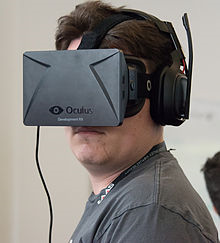Virtual reality: a (very) brief history, part 2
Published 29-NOV-2018 17:03 P.M.
|
3 minute read
Hey! Looks like you have stumbled on the section of our website where we have archived articles from our old business model.
In 2019 the original founding team returned to run Next Investors, we changed our business model to only write about stocks we carefully research and are invested in for the long term.
The below articles were written under our previous business model. We have kept these articles online here for your reference.
Our new mission is to build a high performing ASX micro cap investment portfolio and share our research, analysis and investment strategy with our readers.
Click Here to View Latest Articles
After Virtual Boy’s commercial failure in 1995, VR's immediate fate was sealed: it was a scam. Overhyped. Fake news. It became known as the concept whose time had not yet come.
Enter the Matrix.
While The Lawnmower Man (1992) was the first film to use the term ‘virtual reality’, I would argue that The Matrix (1999) takes heavy responsibility for the VR landscape we see today.
When Neo realises that his very existence is an elaborate simulation (while his real body is in stasis), the Wachowski's film tapped into the dream to create a world beyond the present.
Want to become a pianist? Master multiple forms of MMA? Like pineapple on pizza? Take the red pill.

It was this (now poorly dated) film that captured the imagination of Palmer Luckey, the founder of Oculus VR.
Thanking our Luckey stars
Luckey, a self-confessed fan of the sci-fi genre, had grown increasingly frustrated with the state of head-mounted displays on the market.
In 2012, he addressed his displeasure by doing what any typical 17 year-old would do — he built a multi-million dollar company: Oculus VR.
While Oculus has since arguably been surpassed by several other players in the space (such as Sony, Google and HTC), its pioneer status can't be disputed.

To give you an idea of just how thirsty consumers were for VR to be a ‘thing’, look no further than Oculus’ Kickstarter campaign.
Luckey had a simple vision: 'give me your money and I’ll do VR justice'.
It didn’t matter that Oculus had no employees, no proof of concept, no prospectus, no office. He was going to make VR great again.
In August 2012, the company launched its US$250k Kickstarter campaign and raised a whopping US$2.5 million in return.
This campaign led to the following models:
- Development Kit 1 (DK1): Released on 29 March 2013, it used an 18cm screen which featured low pixel switching time. This meant that latency and motion blur were significantly limited when the user moved their head or made sudden movements
- HD prototype: This fresh prototype was debuted at the Electronic Entertainment Expo. It used a 1080p LCD display, therefore increasing the resolution (it did not ship to public)
In March 2014, Mark Zuckerberg and his data-hungry brethren bought the tech start-up for US$2.3 billion.

The move was ridiculed by backers of the Kickstarter, who felt that the sale was in direct contradiction of Luckey’s initial crowdfunding shift. While I understand the angle these kinds of views come from, it’s unlikely Oculus would have finalised its go-to-market headset without the supervision of the social network.
After the Facebook merger, Oculus released the following:
- Development Kit 2 (DK2): Oculus shipped DK2 in July 2014, which featured a higher resolution (960x1080p) OLED display and higher refresh rate. By February 2015, this model shipped over 100,000 units.
- Crescent Bay prototype: Released in September 2014, this version was lighter than the DK2 while boasting better resolution and 360 degree head tracking.;
- Consumer Version: The crème da le crème. In March 2016, the first batch of the Oculus Rift consumer version shipped.
But... where’s the actual game?
Thanks to the release of Jurassic World VR earlier this year, I am tantalisingly close to hunting my favourite dinosaurs (but where is Jeff Goldblum?).
All jokes aside: despite the fact that gaming has been the mainstay of VR tech to date, studios and developers have lagged behind.
Depending on what your definition of ‘game’ is, there’s no shortage of VR games on the market.
However, at present, the VR experience is an amazing tech demo and nothing more.
That’s not to say that VR isn’t the best it’s ever been: you can do a commando roll while shooting the bad guys or perform surgery with your hands (hilarity will ensue, believe me), but once your initial buzz wears off, you’re just an adult wearing a ridiculous headset.
Until studios find a way to bring the same rich experience to VR headsets as they do for conventional console players, it will remain a gimmick in the gaming industry.
In part 3 of this series, I will explore the other potential applications for VR tech, moving forward.
General Information Only
S3 Consortium Pty Ltd (S3, ‘we’, ‘us’, ‘our’) (CAR No. 433913) is a corporate authorised representative of LeMessurier Securities Pty Ltd (AFSL No. 296877). The information contained in this article is general information and is for informational purposes only. Any advice is general advice only. Any advice contained in this article does not constitute personal advice and S3 has not taken into consideration your personal objectives, financial situation or needs. Please seek your own independent professional advice before making any financial investment decision. Those persons acting upon information contained in this article do so entirely at their own risk.
Conflicts of Interest Notice
S3 and its associated entities may hold investments in companies featured in its articles, including through being paid in the securities of the companies we provide commentary on. We disclose the securities held in relation to a particular company that we provide commentary on. Refer to our Disclosure Policy for information on our self-imposed trading blackouts, hold conditions and de-risking (sell conditions) which seek to mitigate against any potential conflicts of interest.
Publication Notice and Disclaimer
The information contained in this article is current as at the publication date. At the time of publishing, the information contained in this article is based on sources which are available in the public domain that we consider to be reliable, and our own analysis of those sources. The views of the author may not reflect the views of the AFSL holder. Any decision by you to purchase securities in the companies featured in this article should be done so after you have sought your own independent professional advice regarding this information and made your own inquiries as to the validity of any information in this article.
Any forward-looking statements contained in this article are not guarantees or predictions of future performance, and involve known and unknown risks, uncertainties and other factors, many of which are beyond our control, and which may cause actual results or performance of companies featured to differ materially from those expressed in the statements contained in this article. S3 cannot and does not give any assurance that the results or performance expressed or implied by any forward-looking statements contained in this article will actually occur and readers are cautioned not to put undue reliance on forward-looking statements.
This article may include references to our past investing performance. Past performance is not a reliable indicator of our future investing performance.
